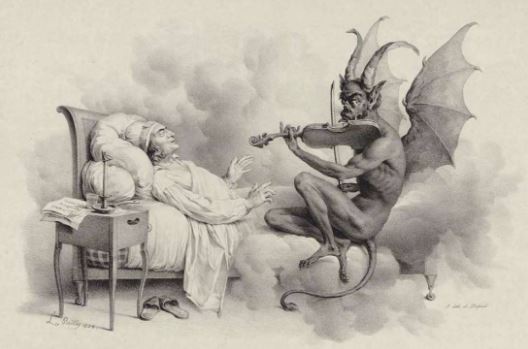Monday evening, I set up my composition idea as planned: three triangle oscillators feeding a sine shaper, with two of them under polymetric control from Teletype (3-in-8 vs 4-in-9 Euclidean rhythms) and one under manual control.
It was frankly pretty boring when I was just using octaves. So I decided to go off the rails a bit and sequence pitches with the Sputnik 5-Step Voltage Source. I clocked it with the master clock, regardless of the rhythmic pattern; the first voice used a channel directly and the second sampled a channel every 8 clock steps. So what we’d get is a complex pattern that starts something like this:

Where time runs left to right, and each color in each lane represents a knob on the 5-Step (not necessarily indicating what the pitch value is set to, nor is “red” on the top and bottom necessarily the same pitch but sometimes they are, and different colors within the same lane are in some cases tuned to the same pitch). The pattern in the top lane runs for 40 beats before repeating, and the bottom lane runs for 72 beats. Because these two are interacting thanks to the sine shaper, they can’t be thought of as individual parts and so it’s going to take 2880 beats for the pattern to repeat. At the tempo I used, the whole recording is roughly 1/10 of a full cycle. (Or… it would be, except I put the two patterns under manual control, suppressing the triggers while letting the sequencer keep clocking. Monkey wrench!)
Complex patterns from relatively simple rules. But that was kind of a tangent — the point is, the frequencies I dialed in, relative to each other, often collided in non-integer ratios. Even if they sound good as individual notes played together, when you use them in phase modulation things get a bit dissonant and skronky, with new sidebands at weird frequencies.

This is the 21st century — beauty is complex, artistic merit isn’t directly tied to beauty, we’re not limiting ourselves to Platonic perfection, and the idea that certain intervals and chords could accidentally invoke Satan isn’t something we lose sleep over anymore. I think the result I got is pretty neat! But it’s not really what I had originally imagined. So I’m going to keep the basics of this idea, follow a different branching path with it and see where that goes.
The third voice, I controlled with the 16n Faderbank — one slider for level, one for pitch. The latter went through the ER-301’s scale quantizer unit, so it always landed on something that fit reasonably well with the other two voices. It turns out this unit supports Scala tuning files, and TIL just how crazy those can get.

Scala is a piece of software and a file format which lets you define scales quite freely — whether you just want to limit something to standard 12TET tuning, or a subset of that (such as pentatonic minor), or just intonation, non-Western scales, xenharmonic tunings, or exactly matching that slightly-off toy piano. The main website for Scala has an archive of 4800 different tuning files and that’s just too much. This is super-specialist stuff with descriptions such as:
- Archytas[12] (64/63) hobbit, sync beating
- Supermagic[15] hobbit in 5-limit minimax tuning
- Big Gulp
- Degenerate eikosany 3)6 from 1.3.5.9.15.45 tonic 1.3.15
- Hurdy-Gurdy variation on fractal Gazelle (Rebab tuning)
- Left Pistol
- McLaren Rat H1
- Weak Fokker block tweaked from Dwarf(<14 23 36 40|)
- Semimarvelous dwarf: 1/4 kleismic dwarf(<16 25 37|)
- Three circles of four (56/11)^(1/4) fifths with 11/7 as wolf
- Godzilla-meantone-keemun-flattone wakalix
- One of the 195 other denizens of the dome of mandala, <14 23 36 40| weakly epimorphic
With all these supermagic hobbits and semimarvelous dwarves and Godzilla, and all the other denizens with their Big Gulps and pistols, where do I even start with this? The answer is, I don’t. I’ll just try making a couple of my own much simpler scales that I can actually understand. Like 5EDO — instead of dividing an octave into 12 tones, divide it into 5.
